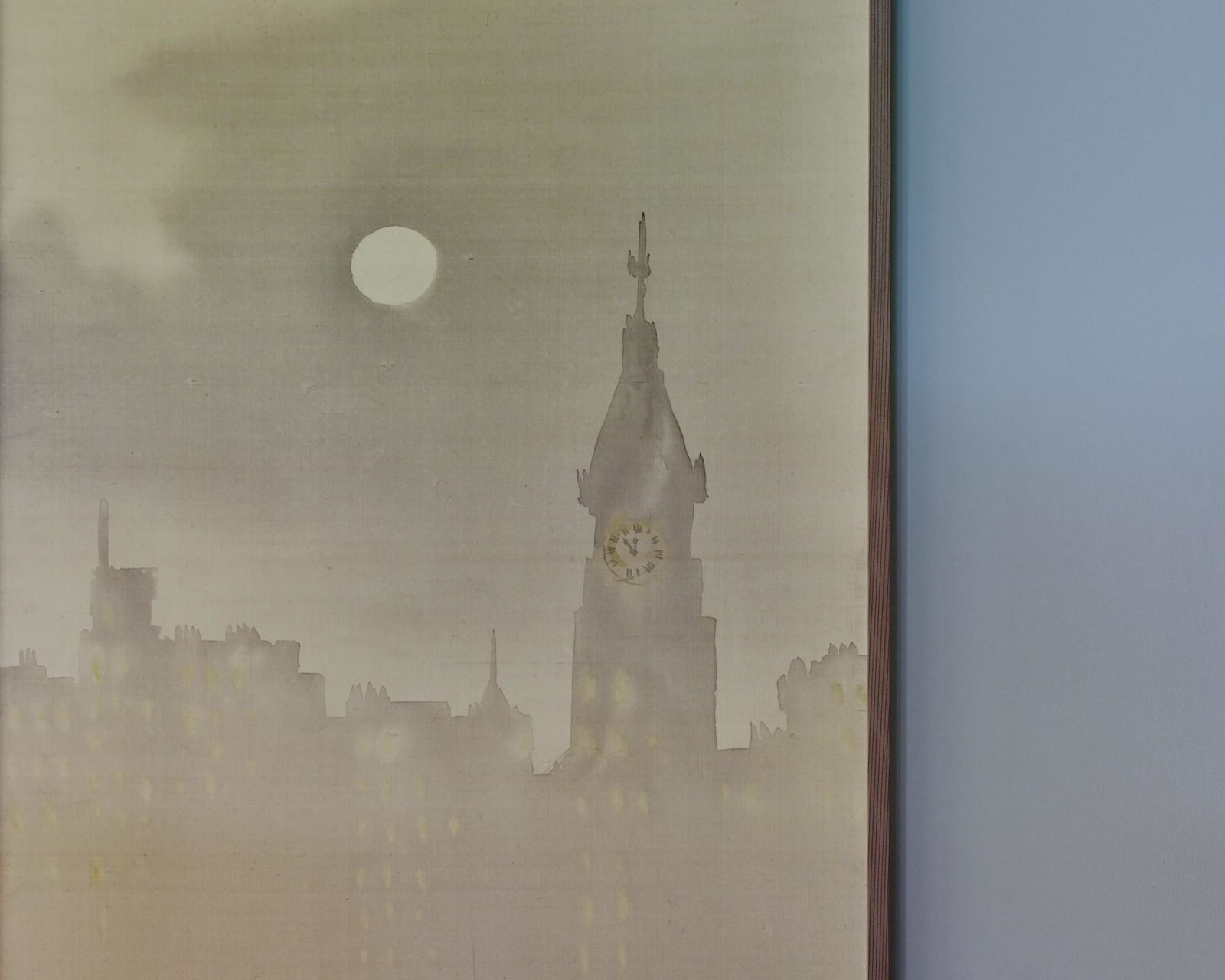Shimomura Kanzan (1873–1930)
Evening View of London
Ink and light color on silk, framed
With a certificate of authenticity by Toobi
Seal: Kanzan
108 x 42 cm
110 x 44 cm (overall)
Further images
The silhouette of a clock tower is seen faintly, drenched in the light of the full moon shining in the mid-sky. The barely legible clock will soon show midnight, but looking at the boats on the river and the people and cars passing by on the bridge the viewer might imagine boisterous noise of a lively scenery. Given the location of London, one quickly thinks of Westminster Bridge and Big Ben when considering the bridge in the foreground and the clock tower behind, but the details of the latter are slightly different from Big Ben, and therefore it is not so easy to identify the scene. In Kanzan’s sketch London Evening, Big Ben, is drawn realistically from a position of about the current London Aquarium, but in another work also called Evening View of London (c. 1909) that shares with the present one its overall composition the contours of the tower are completely different. Taking such discrepancies into consideration, it seems likely that Kanzan based the clock tower and details of the cityscape on actual observation in London but later rearranged these motifs in the studio. The haziness of the work reminds of the morotai style championed by Yokoyama Taikan and Hishida Shunso, central members of the Japan Art Academy. At the same time, works showing the Thames at twilight such as the Nocturne paintings by James Abbott McNeill Whistler come to mind.
Kanzan left Yokohama on February 21, 1903 on the Hakata Maru for England, and arrived in London on April 21, celebrating his 31st birthday on April 10 at sea. Soon after, he entered a boarding house where Natsume Soseki had been living until shortly before Kanzan’s arrival, and for about two years until March 1905 made it his base to study Western art. Kanzan had the good fortune to make the acquaintance of Arthur Morrison, a well-known novelist who as the author of The Painters of Japan even in Japan had reached a certain renown. With Morrison’s help Kanzan was able to study and copy Western masterpieces, especially English watercolors, at the British Museum and the National Gallery.
By the way, in January 1903, just a month prior to Kanzan’s departure for London, Yokoyama Taikan and Hishida Shunso embarked on a tour to India. After their return to Japan in July, both traveled to the United States in February 1904, this time joined by the lacquer artist Rokkaku Shisui. For an opening of an exhibition in Boston, Kanzan also sent works from London that garnered a positive response. When Shisui met Kanzan again in Japan after their return, he was surprised at the degree to which Kanzan had mastered Western painting techniques and at his ideas to incorporate its strengths such as in terms of color into nihonga. It is interesting to note that Shisui in “Remembering Shimomura Kanzan” (Monthly Bulletin of the Friends of the Tokyo School of Fine Arts, vol. 29 no. 2) acknowledged Kanzan’s contributions as follows: “Kanzan introduced a completely new mode of color, derived from Western painting, breaking with the conventions of nihonga.”
Shimomura Kanzan (nihonga painter; 1873–1930)
Nihonga painter from Wakayama. Kanzan graduated from the Tokyo School of Fine Arts. He was a disciple of Kano Hogai and Hashimoto Gaho. Together with Yokoyama Taikan and Hishida Shunso, Kanzan was one of the central members of the Japan Art Institute; he played an important role in its later revival. Professor at the Tokyo School of Fine Arts and designated Imperial Household Artist.
Kanzan left Yokohama on February 21, 1903 on the Hakata Maru for England, and arrived in London on April 21, celebrating his 31st birthday on April 10 at sea. Soon after, he entered a boarding house where Natsume Soseki had been living until shortly before Kanzan’s arrival, and for about two years until March 1905 made it his base to study Western art. Kanzan had the good fortune to make the acquaintance of Arthur Morrison, a well-known novelist who as the author of The Painters of Japan even in Japan had reached a certain renown. With Morrison’s help Kanzan was able to study and copy Western masterpieces, especially English watercolors, at the British Museum and the National Gallery.
By the way, in January 1903, just a month prior to Kanzan’s departure for London, Yokoyama Taikan and Hishida Shunso embarked on a tour to India. After their return to Japan in July, both traveled to the United States in February 1904, this time joined by the lacquer artist Rokkaku Shisui. For an opening of an exhibition in Boston, Kanzan also sent works from London that garnered a positive response. When Shisui met Kanzan again in Japan after their return, he was surprised at the degree to which Kanzan had mastered Western painting techniques and at his ideas to incorporate its strengths such as in terms of color into nihonga. It is interesting to note that Shisui in “Remembering Shimomura Kanzan” (Monthly Bulletin of the Friends of the Tokyo School of Fine Arts, vol. 29 no. 2) acknowledged Kanzan’s contributions as follows: “Kanzan introduced a completely new mode of color, derived from Western painting, breaking with the conventions of nihonga.”
Shimomura Kanzan (nihonga painter; 1873–1930)
Nihonga painter from Wakayama. Kanzan graduated from the Tokyo School of Fine Arts. He was a disciple of Kano Hogai and Hashimoto Gaho. Together with Yokoyama Taikan and Hishida Shunso, Kanzan was one of the central members of the Japan Art Institute; he played an important role in its later revival. Professor at the Tokyo School of Fine Arts and designated Imperial Household Artist.





